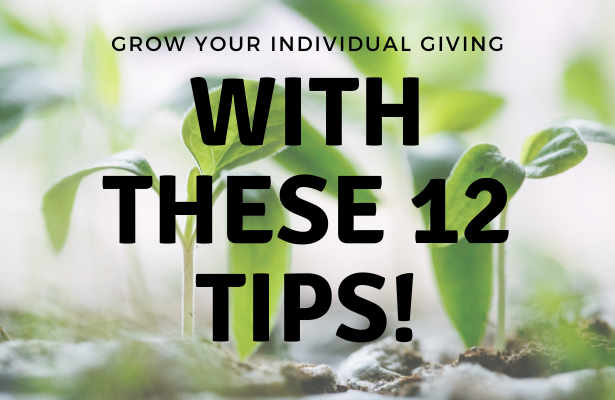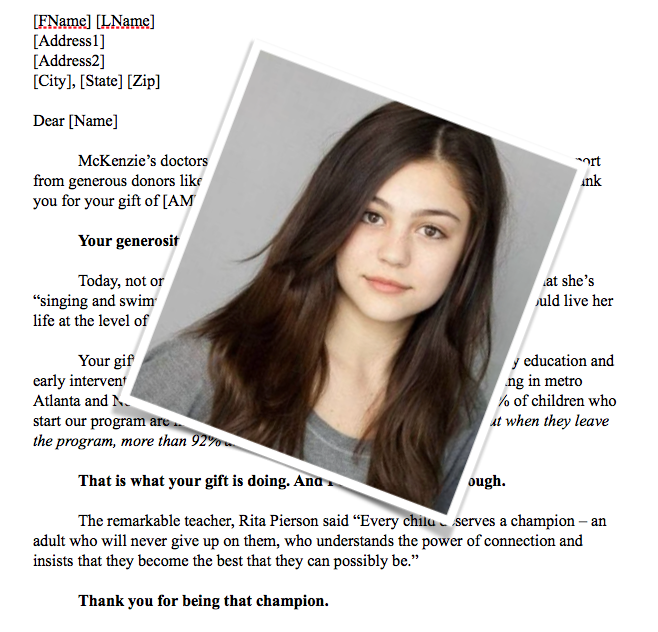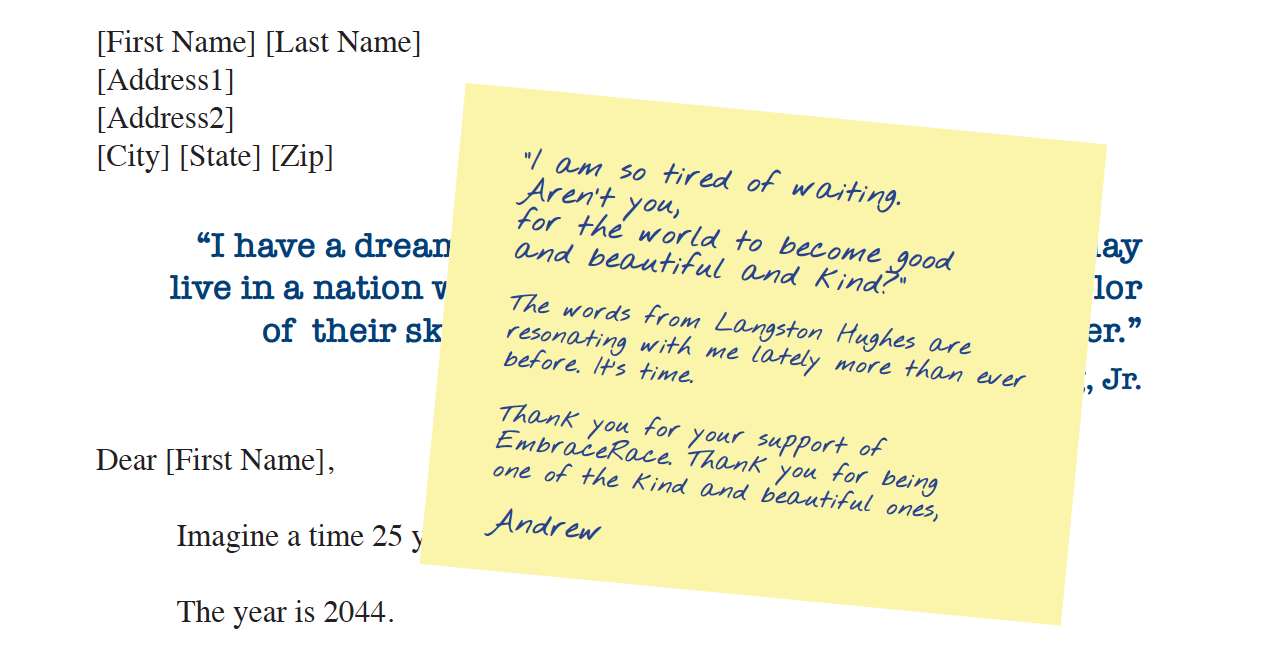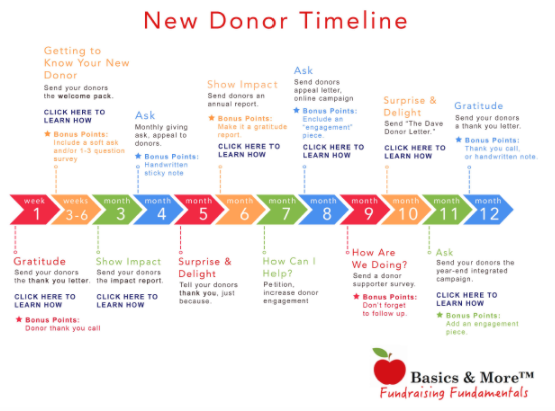 Smart fundraisers know. Growing a strong base of individual funding support will guide your mission through any crisis.
Smart fundraisers know. Growing a strong base of individual funding support will guide your mission through any crisis.
GivingUSA, the barometer of charitable giving in the United States, regularly reveals that roughly 80% of philanthropic giving comes from individuals (factoring in bequest giving).
Growing your individual giving takes strategy, commitment, and a bit of creativity. Here are some of the ways Basics & More students have grown their individual giving programs.
1.) Write a new thank you letter and thank you email for every campaign.
Your thank you represents one of your best opportunities for further engagement. Don’t squander it. Consider completing the story you started in your original appeal and even including a separate photo to “delight and inspire” as we did here.
 Get your free thank you letter template here. Download “before and after” examples here and here.
Get your free thank you letter template here. Download “before and after” examples here and here.
2.) Include a reply envelope.
Including a reply envelope with your next donor newsletter is part of the simple but strategic formula we’ve been teaching in our Nonprofit Donor Newsletters | Basics & More class since 2013. See how one nonprofit raised $20,000 with their very first donor-centered newsletter.
3.) Get your board members involved.
Prep your board to add hand-written notes for your year-end appeal. Now is the best time to begin polling your board members to uncover their connections with donors. Get them busy using colorful Post-It notes to lift response.
4.) Pay attention to your outer envelope.
When you’re planning out your direct mail pack, pay as much attention to the outer envelope as you do the subject line for an email. After all, your first goal is to get opened. Consider your own mail and what stands out. Spring for an oversized envelope. According to Agents of Good, “almost anything other than a white #10 will do better in the mail.” Typically no window and use a stamp, please. Experiment with color, a hand-written font, stickers.
5.) Empower your supporters to fundraise on your behalf.
Your donors love you and want to see you succeed. How are you empowering them to fundraise on your behalf? I’ve been urging clients and students alike to create their own version of this fundraising guide and post it prominently on their website.
6.) Make monthly giving a priority.
Monthly donors have retention rates of 90% and above. Some of our students have monthly donors who are giving $1,000 every month. We recommend 3-5 dedicated monthly giving asks a year. Segment your database and experiment with both direct mail and digital. How easy are you making it to give via EFT? Download our Instant Monthly Giving Ask Template.
7.) Warm up your donors for your end-of-year ask.
When you send a “warm-up” piece prior to your end-of-year campaign (or any campaign), it serves as a method of “priming” your donors for your ask. Derived from Cialdini’s book, Pre-Suasion: A Revolutionary Way to Influence and Persuade, your “warm-up” is one way to make your donors feel important, appreciated, and selfishly fulfilled.
8.) Get a grip on your data.
Jump right in, the water’s warm! Use the months of July and August to get a handle on your data and, if necessary (trust me, it’s probably necessary), hire a professional for an independent data audit. Your data is your best friend. Case in point: I’ve been a monthly donor to one large international charity for over a year and in all that time I’ve never had the slightest indication that they know me. But see how this recent mailing tailored their letter to show me that they know me. Carve out 30 minutes to watch this training with T. Clay Buck for more on a data-inspired look at setting fundraising priorities.
9.) Let your donors know that they mean more to you than a dollar sign with a “non-financial engagement” piece.
Get fun, get creative, and get to know your donors with a non-financial engagement piece. How? See how Basics & More student Julie Edwards saw an 84% increase in her organization’s year-end funding with this tactic.
10.) Know and honor your donor preferences.
Knowing — and just as importantly, honoring — your supporters’ preferences will be more important than ever going forward. As we move into additional channels, you want to be cognizant of how your donors want to hear from you. Their trust is sacred. And when they sign up to receive emails from you, don’t automatically assume they’re also open to texts. You need a donor database that works and you need to ask. Frequently. Make it a point to capture donor preferences throughout the donor journey. Here’s one example.
11.) Have a specific plan in place for stewarding new donors.
First-time donors have a retention rate of only 23%. And donors acquired online have an even lower donor retention rate. You need to have a solid plan in place to nurture your new donors. Develop your own timeline using the examples and strategy in this downloadable New Donor Timeline (includes welcome kit) Your absolute best strategy? Put the processes in place for a thank you phone call for every new donor.
12.) Add a lift note.
Philanthropy Daily describes a lift note as “a short letter that precedes the main letter. Usually, the note comes from someone other than the main letter’s author and is the first thing the reader sees when they open the outside envelope.” Here’s another instance where you can get creative and repurpose. I loved this tiny lift note included with a thank you letter (imagine how often you could repurpose this). “Hand-written” lift notes like this one can also add urgency to a piece.



















 I can’t wait to meet with you personally.
I can’t wait to meet with you personally.
Comments on this entry are closed.